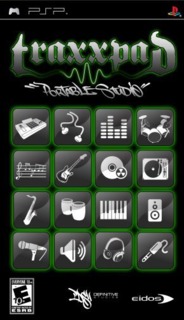A fine application for the casual music composer, with more depth than anyone could reasonably expect from a handheld.
If so, join the club!
Fortunately, Eidos has released a snappy little music editor for people who have no idea how to compose music. It's marketed towards the hip-hop set (but I repeat myself. Ahem), however there's no reason why a person couldn't compose rock, R&D, country, bluegrass or even Polkas using this application (it’s not really a game proper).
The basic structure is broken down into a beat editor (RTIST) a melody editor (MELOD) and a track editor (STAC). I recommend reading the manual thoroughly before starting, as the screen will give you little indication of how to do anything if you don’t.
In RTIST, you can pick two banks of four sounds (more on this later), which are mapped to the four face buttons on the PSP. You select which bank of four you’re playing by tapping the L button. You start recording by pressing and holding the select button, and from there you can either scroll left and right with the joystick and press the appropriate button when you’re in the position you want the note to sound, or you can tap the select button and tap the buttons to the beat of a metronome (which you can disable if you have rhythm)
From there, you take that sequence of one-pitch beats and head over to MELOD, which lets you adjust the pitch, volume, balance, and other characteristics of a particular note. You can also compose in MELOD, but I find it easier to coordinate multiple instruments in RTIST and then alter the pitch in MELOD.
After you’ve gotten your sequence edited the way you want, you save it to your memory stick and map it to one of the four face buttons in the STAC. STAC lets you combine four sequences into full songs. Hold Select to start recording, and you can either place the sequences in realtime as the song plays, or you can place them manually by scrolling with the joystick. You may also use some prerendered sequences, if you just want to get the hang of the tool.
There are other modes, such as the MYXXER, which lets you noodle around with sound banks freestyle without recording anything.
One of the cool features of this application is the ability to export your songs into MP3s on the memory stick. Another is the ability to use a PSP microphone (not included) to record your own sounds and use them in the sound banks mentioned above. The recordings can only last up to about 15 seconds, though, so don’t get the idea that you can record full vocal tracks. (If you want to do that, I recommend creating the instrumental in Traxxpad and editing the exported MP3 using your pc with an audio editor like Audacity). My only real complaint about Traxxpad is the organization of the sounds. A large number of the sounds samples are organized by instrument, which is logical. You have your guitars, your strings (violins, cellos, etc), your woodwinds, your drums, and so forth. Navigating your way to a particular instrument in these categories is a breeze. But the rest of the 1000 samples are organized by what producer uses them, which is kind of like organizing the words in a dictionary by who says them the most often. (“Evening” would be under H, for Hitchcock). This strikes me as a ridiculous way of doing business, and it only makes sense if the user is intimately familiar with the works of the producers in question. I for one have never heard of anyone on the list, but I might be the exception.
The application isn’t super intuitive, but if you read the manual first, and perhaps visit the tutorials on Youtube (search for Traxxpad), you’ll be navigating the various screens in no time. The controls are well laid out once you get used to them, and not a single button is wasted. Indeed, some are used for more than one thing depending on how long you hold them down.
For the frustrated musician, like myself, who wants to create music but has no talent for playing it, this is a fine application to have. It’s portable, lends itself to the easy creation of a surprising variety of music. (I’ve created some bluegrass already. It sounds mechanical, but it’s not bad.) Well worth the $40.

